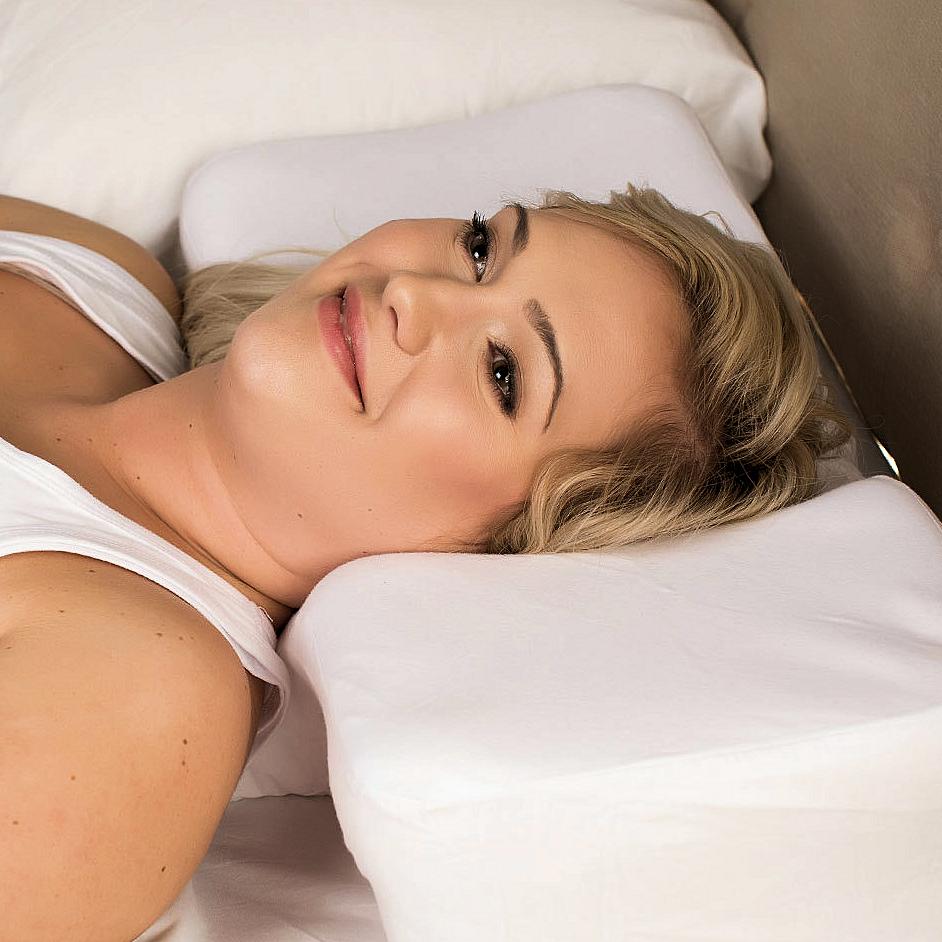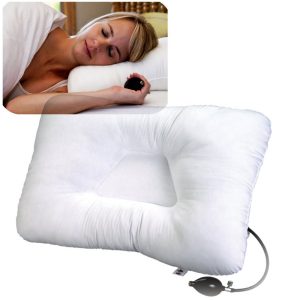Therapeutic Pillow
$107.55 Original price was: $107.55.$96.12Current price is: $96.12.
Therapeutic Pillows Have A Unique Support For The Head, Neck, Upper Back & Shoulders For Sleeping In Perfect Posture In Both Back & Side Sleeping Positions.
Nontoxic, non-allergenic molded foam offers 3 distinct sections to reduce neck pain and stiffness as well as shoulder pain and headaches when sleeping on your back and/or side. May significantly reduce waking up with discomfort and stiffness, permitting you to enjoy rejuvenating rest and suffer fewer related symptoms

Prices & Offers Subject To Change
Read description below for measuring and if it is the right pillow for your needs
When It Comes To Therapeutic Pillows To Promote Correct Neck Alignment Sleeping On Your Back Or Side
These are therapeutic pillows which are designed to properly support the head and neck when back sleeping and side sleeping. Most people sleep in the center of their pillow when they sleep on their backs, the center of these therapeutic pillows are designed specifically for back sleeping with a special wedge for upper back support. When side sleeping, the outside edges of the pillow are designed to support the neck and shoulder with increased height.
Correct Measuring For Therapeutic Pillows

Have someone assist and measure your left shoulder. Stand Facing the person who is measuring you, arms down to your sides. Hold the ruler to the base of the neck. Keep the ruler Level across the shoulder area. Feel for the arm bone and ignore any muscle beyond the bone on the end of the shoulder. Compare size on the ruler, above the end of the arm bone with the diagram to get the proper measurement for your therapeutic neck pillow. Between sizes choose the smaller. In general, if you have a soft bed or you noticeably sink into the bed, choose one size smaller. From ages 6 and up. Also available in a Travel Version.
The unique density of the foam creates a combination of firmness and give which allows for an comfortable, yet supportive nights sleep. It is on the firm side, which is necessary to maintain ergonomic design integrity. The video above gives a good idea of the pillow flexibility.
Why Use This Pillow?
Because most people sleep both on their sides and their backs, these positions require different support to maintain proper neck alignment and head posture. The head needs to be supported approximately two inches higher in the side position than in the back position. Trying to make this correction, you may find yourself putting your hand under a pillow when sleeping on your side. This indicates you need more support in this position and therapeutic pillows will provide this support.
Because of the distinct sleeping areas, you need to be aware of how you change positions. You do not want to sleep on your back in the areas for side sleeping. So, a conscious effort is needed to change positions. This is usually not a problem with acute, painful conditions like neck sprain & strain, whiplash injuries or flare-ups of degenerative spinal conditions.
In the back sleeping position, the head not only needs to be supported at the right height, but prevented from tilting forward and restricting air passages, or from rolling from side to side which can put rotational stress on the neck resulting in muscle soreness and joint pain. Upper back support is also desirable to prevent the weight of the body from pulling the neck out of alignment.
Therapeutic Pillows Providing Superior Support:
 |
|
It incorporates two separate areas into one supportive pillow with different heights for back and side sleeping. A unique orthopedic wedge to support the upper back. The pillow can help eliminate sore and stiff neck problems from sleeping incorrectly. These pillows are patented for both design and function. Helps to reduce snoring, decreases peak pressures and increases support contact areas.
Therapeutic Pillows Feature:
Back Sleeping Therapy |
Side Sleeping Therapy |
|
|
Does It Come With A Cover?
The therapeutic neck pillow comes with a fitted polyester/cotton machine washable zippered pillow cover. Fits into a standard pillow case. They are made of non-allergenic, environmentally-friendly, recycled foam. Available in specific sizes to fit your body contours.
Is This The Pillow For Me?

This is a functional pillow that is very specific in design, having separate areas for back and side sleeping. This is an important factor in maintaining a posture that will relax the neck muscles in either position. When lying on your side, you will need an extra inch or two of height compared to the back in order to compensate for the shoulder.
 It maintains a distinct advantage in supplying the benefits for both sleeping postures in correct postural alignment. This will help ease tension on the muscles, joints and nerves, which may be very sensitive for those experiencing higher levels of neck pain and discomfort. This is a special ergonomic pillow that uses a thoracic support for upper back pain as well.
It maintains a distinct advantage in supplying the benefits for both sleeping postures in correct postural alignment. This will help ease tension on the muscles, joints and nerves, which may be very sensitive for those experiencing higher levels of neck pain and discomfort. This is a special ergonomic pillow that uses a thoracic support for upper back pain as well.
That being said, you must be able to move in a conscious manner when changing positions with the therapeutic pillow. You do not want to wake up on your side, with you head in the middle portion of the pillow. This is not a problem for most who use these type of pillows, however, in consideration of the upper back support, this is a concern if you are a very deep sleeper or if you are taking medication that makes you sleep very deeply and you tend to move around on the pillow frequently. Note: A weighted blanket can help reduce tossing and turning.
For most with significant neck pain, changing positions is painful and it is not a problem to carefully place yourself in the correct place on these pillows. The increased comfort and alignment can help speed up recovery from injury as well as help deal with postural issues for long term users. A distinct advantage of this therapeutic neck pillow is the measuring system which allows a custom fit, so the pillow fits you and you don’t have to fit a one size pillow.
When back sleeping, the pillow places your neck in a lordotic position meaning in the correct curve. This can be a great way to restore the curve over time. However, if you have a condition like facet joint syndrome and/or a military neck that should not be corrected, it may not be the pillow for you when back sleeping. If you have pain when bending your head back or with a neck roll/rolled up towel under the neck, you may need to place a small towel in the center piece to keep the head from arching back similar to the latex orthopedic version.
* It may take some time to get used to the pillow and you should give it a few weeks alternating with your current pillow. The worse the spinal condition, the longer it may take. You may take to it right away and feel it is just perfect, or you may need to gradually introduce it into your sleeping as above.
Some use it strictly as a therapy pillow and use only when symptoms get worse. When the pain subsides, they will switch back to a different style pillow and this is a particular strategy of combining pillows for neck pain management. It also may be used strictly for therapy, similar to the stretching done on the posture pillow. It is a versatile pillow that usually gets results, but it is not for everyone.
Why Does A Pillow Need A Thoracic Wedge?
Reduced mobility of the neck is a common feature of neck pain. The base of the neck is the cervico-throacic junction – where the cervical spine meets the thoracic spine, and the upper back is often involved with neck pain. There are muscles like the trapezius which span the head, neck and upper back.
 Whiplash injuries involves forceful loading of the upper back muscles and damage to the trapezius has been documented in neck injuries where muscle fibers insert into bone [1], which results in an enthesis and myofascial dysfunction called myofascial-entheseal dysfunction.
Whiplash injuries involves forceful loading of the upper back muscles and damage to the trapezius has been documented in neck injuries where muscle fibers insert into bone [1], which results in an enthesis and myofascial dysfunction called myofascial-entheseal dysfunction.
Myofascial refers to the muscles and surrounding connective tissue, while enthesis is the area where ligaments, tendons, and joint capsules insert into bone. This area transmits loading the muscles to the respective bone attachment, while dissipating the force away from the enthesis itself – from tendon to bone.
In whiplash injuries, over 65% of acute injuries involve thoracic pain [2], and over 80% of chronic pain involves the upper back [3]. Weakness of the trapezius is involved in forward head posture and perpetuates a progressive postural dysfunction known as upper crossed syndrome.
The thoracic spine can limit motion of the neck as well as be involved in postural and soft tissue abnormalities that contribute and even perpetuate neck pain, especially in chronic conditions. The thoracic spine directly contributes up to 21% of neck rotation and up to 33% of neck flexion [4].
Mobility of the thoracic spine is reduced in patients with chronic neck pain and associated with respiratory strength. Those with chronic pain in the neck often have biomechanical changes of the cervico-thoracic spine as well as the rib cage [5]. This can contribute to breathing problems and the pillow may also be used for breathing exercises and consideration for the cervical and thoracic spine may contribute to improved respiration and oxygenation in rehabilitation for those with chronic neck problems.
Therefore, the thoracic wedge is a therapeutic part of the pillow that is ergonomically incorporated and sized to be an anatomical postural support for the upper back that contributes to the biomechanical restoration, decreases musculoskeletal stress, and may improve breathing when back sleeping. The relationship is maintained when side sleeping on the therapeutic pillows with the correct height along with proper angling of the neck and shoulder piece. Reduced mobility in the upper thoracic spine explains 14% of neck-shoulder pain and 15% of weakness in the hands [6].
[1] Myofascial-entheseal dysfunction in chronic whiplash injury: an observational study. JRSM Short Rep. 2012 Aug;3(8):57
[2] Whiplash injury is more than neck pain: a population-based study of pain localization after traffic injury. J Occup Environ Med. 2010 Apr;52(4):434-40
[3] Widespread pain following whiplash-associated disorders: incidence, course, and risk factors. J Rheumatol. 2007 Jan;34(1):193-200
[4] Normal kinematics of the neck: the interplay between the cervical and thoracic spines. Man Ther. 2013 Oct;18(5):431-7
[5] Differences of spinal curvature, thoracic mobility, and respiratory strength between chronic neck pain patients and people without cervical pain. Ann Rehabil Med. 2020 Feb;44(1):58-68.
[6] Clinical symptoms related to musculoskeletal neck-shoulder pain and mobility in the cervico-thoracic spine. Scand J Rehabil Med. 1998 Dec;30(4):243-51.
Additional information
| Pillow Size | Petite, Average, Large, X-Large |
|---|



















